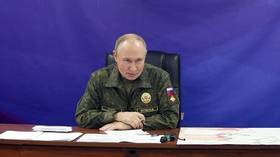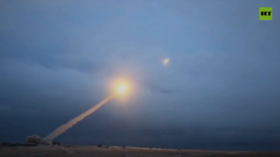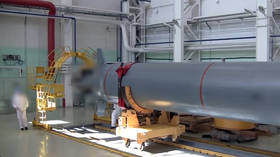President Vladimir Putin has met wounded Russian servicemen and spoken of new cutting-edge additions to the county’s arsenal
Russian President Vladimir Putin visited a military hospital in Moscow on Wednesday, meeting servicemen wounded in the Ukraine conflict. The president spoke about the frontline situation, namely the encirclement of Kiev’s troops in two critical locations, as well as the testing of new cutting-edge nuclear-powered weaponry, including the unlimited-range Burevestnik cruise missile and the massive Poseidon underwater drone.
Here are the key takeaways from Putin’s speech:
Moscow ready for pause in fighting
The frontline situation has been developing “favorably” for Russia, with the country’s troops actively advancing, the president said. Ukrainian forces have been encircled in Kupyansk and Krasnoarmeysk (Pokrovsk), Putin added, referring to cities in Ukraine’s Kharkov Region and Russia’s Donetsk People’s Republic, respectively.
The president floated the idea of briefly pausing fighting in the two locations to allow Western and Ukrainian journalists in. The proposal has already been discussed with military commanders and Russian Defense Minister Andrey Belousov, Putin added.
The journalists would be able to “check on the state of the encircled Ukrainian troops so that Ukraine’s political leadership can make appropriate decisions regarding the fate of its citizens and military personnel,” the president said. The trickiest part about the proposal is ensuring the safety of the journalists and preventing a potential provocation by Kiev, he said.
Cruise missile of unlimited range
The Russian president talked about the new unlimited-range nuclear-powered Burevestnik cruise missile. The weapon was successfully tested last week, when the projectile reportedly traveled more than 14,000km.
Putin revealed details about the missile’s nuclear-powered turbojet engine, stating that its power unit “is comparable in output with the reactor of a nuclear-propelled submarine, but it’s 1,000 times smaller.”
“The key thing is that while a conventional nuclear reactor starts up in hours, days, or even weeks, this nuclear reactor starts up in minutes or seconds. That’s a giant achievement,” the president said.
The nuclear-powered propulsion system could potentially see civilian application, apart from military use, Putin noted. For instance, it could be applied in the future to “address energy security in the Arctic, and we’ll use it in the lunar program,” he said.
Poseidon underwater drone tested successfully
Russia successfully tested a nuclear-powered underwater Poseidon drone on Tuesday, Putin revealed. The development of the massive torpedo-shaped nuclear-capable drone was first announced in 2018, but had been shrouded in mystery ever since.
“For the first time, we succeeded not only in launching it from a carrier submarine using a booster engine but also in starting its nuclear power unit, which propelled the drone for a certain amount of time,” Putin stated.
The device is unrivaled by any other weapon “anywhere in the world when it comes to speed and depth,” the president stressed, adding that an analogous weapon is unlikely to be fielded by any other nation soon. The power of Poseidon greatly surpasses the characteristics of Russia’s upcoming Sarmat intercontinental ballistic missile (ICBM), Putin stated, apparently referring to the yield of its nuclear payload.
Sarmat ICBM to be fielded soon
The Sarmat ICBM itself is expected to enter active duty shortly, the president stated. The missile was first approved for military duty in September 2023, and is set to replace the aging R-36M family of silo-based nuclear-armed ballistic missiles.
The Sarmat reportedly has an estimated range of 11,000 miles (about 18,000 kilometers), with a ten-ton payload.
“There is no other [missile] like the Sarmat in the world, and we don’t have one on duty yet – it will be on duty soon,” Putin said.























